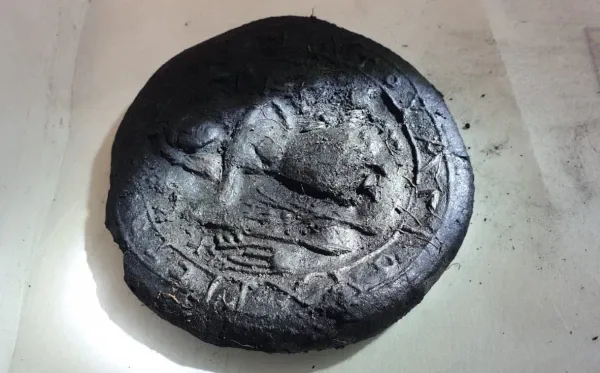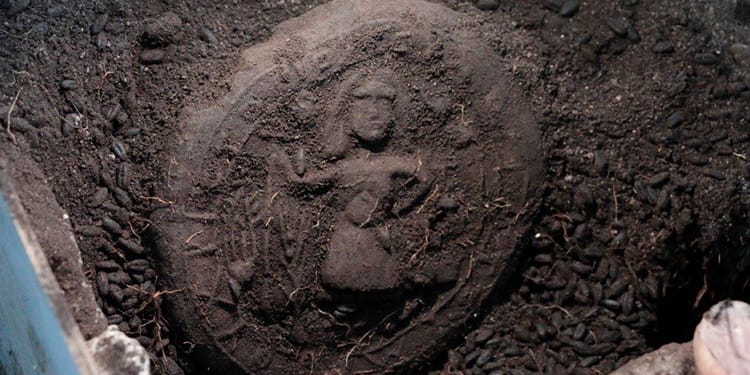1,300-Year-Old Communion Bread Bearing Image of Christ Discovered in Turkey

Karaman Province, Turkey - Archaeologists excavating the ancient Byzantine city of Eirenopolis in southern Turkey have discovered five exceptionally preserved communion bread loaves dating back approximately 1,300 years, one of which bears an image of Jesus Christ and a Greek inscription.
The discovery took place at the Topraktepe archaeological site in Karaman province, located in the historical region of Anatolia. The excavations were conducted under the leadership of the Karaman Museum Directorate with permissions from Turkey's Ministry of Culture and Tourism.
The carbonized loaves, made from barley, date from the seventh to eighth centuries AD, during the Byzantine Empire's rule over the region. According to researchers, these are the best-preserved examples of their type ever found in Anatolia, having survived due to carbonization and the oxygen-free environment where they were discovered.

The most remarkable loaf features a unique depiction of Jesus Christ portrayed as a "sower" or "farmer," accompanied by a Greek inscription reading, "With our gratitude to Blessed Jesus" (translated from ancient Greek). This representation differs significantly from the traditional "Christ Pantocrator" imagery common in Byzantine art, which typically depicts Jesus in a majestic pose holding the Gospel.
The four remaining loaves bear distinctive cross-shaped imprints, specifically Maltese cross motifs, consistent with early Byzantine liturgical practices where bread was stamped with sacred symbols before being consecrated for the Eucharist.
According to the official statement from the Karaman Governorship, posted on social media on October 8, 2025, the farmer Christ imagery reflects "the symbolic importance of abundance and labor in the religious understanding of the period."
The depiction recalls the Parable of the Sower from the New Testament, symbolizing faith spreading like seeds and connecting divine grace with human agricultural labor. In Byzantine rural communities dependent on successful harvests for survival, portraying Christ as an agricultural laborer represented divine blessing over essential community work.
Giovanni Collamati, a professor of history specializing in the Middle Ages at CEU San Pablo University in Madrid, Spain, explained to ACI Prensa (Catholic News Agency's Spanish-language partner) that the discovery is significant because "the iconography of Christ changes over time." He noted that finding this variant imagery in a provincial city rather than a major center like Constantinople provides clues to historically unknown forms of liturgical worship.
Eirenopolis, meaning "City of Peace" from the Greek words "eirene" (peace) and "polis" (city), was an important bishopric center during the Roman and Byzantine periods under the Patriarchate of Constantinople. Located in the historical region of Isauria, the city held ecclesiastical importance despite not being a major urban center.

The exceptional preservation of these loaves provides tangible evidence of ritual customs previously known primarily through textual sources and iconographic representations. Eucharistic bread held central importance in Christian liturgy, representing the body of Christ in Holy Communion. Eastern Orthodox practice traditionally employed leavened bread, symbolizing life, resurrection, and spiritual fullness.
Archaeologists plan to conduct chemical and botanical analyses to determine which grains and leavening agents the bakers employed and to confirm whether the loaves were leavened prosphora (Greek: προσφορά, meaning "offering") or served another liturgical purpose. Researchers also hope to locate a nearby chapel that might have stored the bread.
The Topraktepe site has already yielded significant material culture including necropolises, rock-cut chambers, and fortifications, but officials note that few artifacts have spoken so directly to everyday devotion in the Byzantine era.
This discovery follows other remarkable bread finds in Turkey in recent years. In 2024, archaeologists found carbonized bread at the Neolithic site of Çatalhöyük believed to be 8,600 years old, the oldest bread ever discovered. Earlier in 2025, archaeologists excavating a Bronze Age settlement in Turkey discovered 5,300-year-old charred bread that may have played a role in ancient rituals.

THE CRUSADERS OPINION
This remarkable discovery testifies to Christianity's deep roots in Anatolia in Ancient Greece and the devotion of Byzantine believers who elevated even daily bread into sacred worship.
These 1,300-year-old loaves survived ONLY because faithful Christians treated communion with profound reverence.
The farmer Christ imagery beautifully illustrates how early believers understood God's intimate involvement in every aspect of life, including agricultural labor. This wasn't abstract theology; it was faith woven into survival.
While Islam later conquered these lands, Christianity flourished here for centuries, building magnificent churches and practicing sacramental worship that honored Christ's presence in the Eucharist.
These preserved communion loaves remind us that Christian civilization once thrived where secularism and Islam now dominate.
The Greek inscriptions, cross symbols, and careful preparation demonstrate that Byzantine Christians across all social classes worshipped with excellence and gratitude.





